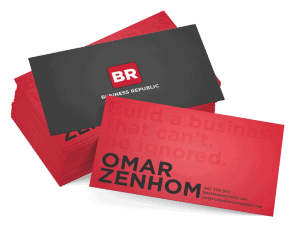The business card: if the art of business can be summed up by a single object, this is it. A business card is the first token of a potential professional relationship. It can be the first step of a dance between business partners, or the opening salvo in the battle for clientele and strong networks. It can be the reason someone offers you the opportunity to do what you’ve chosen to do for a living. Designed well and offered properly, a business card is a small but vital part of the competent businessperson’s arsenal.
It may seem like business cards are less relevant in the age of e-commerce and general paperlessness, but that’s a misreading of modern commerce. Business cards are still relevant in the same way that business people still are: as components of the physical world in which all business ultimately takes place, no matter how digitized. Ultimately, business is something people do with people, and a quality card is the first step towards establishing yourself as someone with whom business is worth doing.
A business card has essentially one function: to cause you to be remembered. That means that the card itself has to be memorable, by being as unique and impressive as you are. It also means that the way in which the card is presented has to be memorable, by being a conscious act and not an absent, automatic gesture.
If you’re to be remembered, your business card has to act as a wallet-sized surrogate for yourself, bridging the gap between the time it’s received and the moment the recipient uses it to reach out for that second contact.
The Layout
A quality business card is simple, but evocative. It’s unique, but unpretentious. It denotes seriousness, but also creativity and wit. It uses as few words and graphics as possible to convey as much about your business as a few square inches of card stock can. It creates a lasting visual impact that the recipient files away into that part of the subconscious where things about which we want to know more are stored.
The first rule is not to overload the card with too much information. Too many words can turn an introduction into a reading assignment, and the things that matter can get lost in the deluge. Use only the information the recipient will need to remember who you are, what you do, and how best to reach out and get things started. Your name, the name of your business, and a web address may be all that’s needed.
For example, if the recipient is a potential client, and you run an online business, there’s no need for a phone number. If you have more than one email address, pick one. If your business address isn’t an actual storefront, forget it. Every word cuts into a very small budget of space- both on the card and on the mental palate of the recipient’s first impression.
Fortunately, the 21st century is a great time for super-efficient use of card space, thanks to the Internet. As long as your business has an online presence (it does, right?), a web address or social media handle is all the recipient of your card needs to access the rest of your information.
For the truly futuristic minimalist, a simple QR code can replace anything that would otherwise have to be printed. Of course, a business card with only a QR code may seem too impersonal, so think of it as a supplement that allows the rest of the design to be appropriately sparing.
Besides contact info, the content of the card should very succinctly encapsulate the essence of your business. It should, in as few words as possible, declare what your business can do better than anyone else’s. “IT Solutions.” “Fitness on your schedule.” “Expert grooming for TODAY’S ferret enthusiast.” Whatever it is, boil it down to a confident slogan that will convince the recipient to reach out and learn more.
Making an Impact
A great business card is unique. The best way to make yours truly stand out is through its graphic layout. Colors, patterns, aesthetically interesting symbols- these are your opportunities to burn an impression into the memory of the recipient. Be cautious, however, because this doesn’t mean that the card should be loud, obnoxious or cluttered. Think Andy Warhol, not Ed Hardy.
For example, our card here at Business Republic is immediately eye-catching thanks to a simple, liberal use of one bright color:

The vibrant hue makes it unforgettable, and it also makes the card look less like a random piece of refuse. Subconsciously, the color denotes that the card itself has some value, simply by virtue of not being the color of scrap paper. It’s a basic psycho-aesthetic statement that turns card stock into something that mysteriously seems wrong to discard.
By keeping the primary focus on one thing (the contact name) and printing the rest relatively small, the card encourages closer inspection. This urge to really look at the card, not just glance at it, is further encouraged by the slogan subtly printed on the background. Contrasted with the bold and somber font of the contact info, it draws the recipient in.
The card works well, and is more likely to lead to a second contact, because it has strong visual impact. By being interesting and memorable, the card helps the recipient remember the person who gave it to them, especially if it’s offered in the proper way (more on that below).
Great design is worth the investment, and these days there are plenty of great online card printers that offer professional design quality at affordable prices. On sites like vistaprint.com and moo.com, even the higher-end models are reasonably priced. For something more strictly personalized, freelancer.com is a great resource for customized graphic design. Take advantage.
The Material
Besides finding a simple, bold aesthetic scheme for your business card, it’s also important to have it printed on quality material. A card that’s flimsy or paperlike isn’t the mark of a professional who cares. Remember, the card is a reflection of your business, so you want it to have a certain heft, and therefore a certain gravitas. When it comes to card stock, thickness is seriousness.
No matter how great the design is (or how affordable the price is), physical flimsiness is the business card equivalent of faux-wood paneling. It’s the greasy pompadour of the used car salesman. It is, in a word, unprofessional. If a printer is offering prices that seem too good to be true, be wary that inferior materials could be the reason.
The Handover
Once you’ve designed and printed the card, the next step is getting it out there. Opportunities for networking are everywhere, so always keep a few in your wallet- and bring more than a few to workshops and professional conferences.
The way a business card is offered matters. Too often, it’s done passively, in mid-conversation or even mid-sentence. This absent-minded approach is part of the reason so many business cards end up in the trash can (after a brief residence in a back pocket). In order to make a business card worth the effort and expense of printing, the handover has to be a conscientious act.
Take the example of Japan, perhaps the only place where business is consciously performed as an art unto itself. There, the proffering and accepting of business cards is a sacred, ritualized act. The card itself is treated reverentially, and to casually slip one into a pocket is an unpardonable offense.
While the complex ritual would be seen as overkill in other parts of the world, the Japanese have the right idea generally. When offering your card, take the time to spotlight it. This is no time to multi-task. Stop whatever else you’re doing, and present the card as if it’s something valuable, which it is. By using the same social cues and mannerisms one would use to give someone a gift, the recipient is obliged to at least take the time to glance at it, and to put it somewhere they’re likely to find it again.
By making this act a conscious one, you’re implanting a memory. By obliging the recipient to look at your card for just a few seconds, you’re creating an automatic subconscious association between yourself and your (impressive) card. To do otherwise is to waste a valuable tool.
In business, the little things matter. By putting time and effort into its design, and care and mindfulness into its presentation, a tiny piece of card stock can be the key to new business opportunities. Treat your business card like you treat your business itself- worth investing in, worth getting right, and worth offering to the world. The results can be a lot bigger than 3.5” x 2”.
And just for kicks, enjoy this scene from American Psycho.

Start your escape plan today, with our free business building starter pack.
Free newsletter. No spam. Unsubscribe any time.

